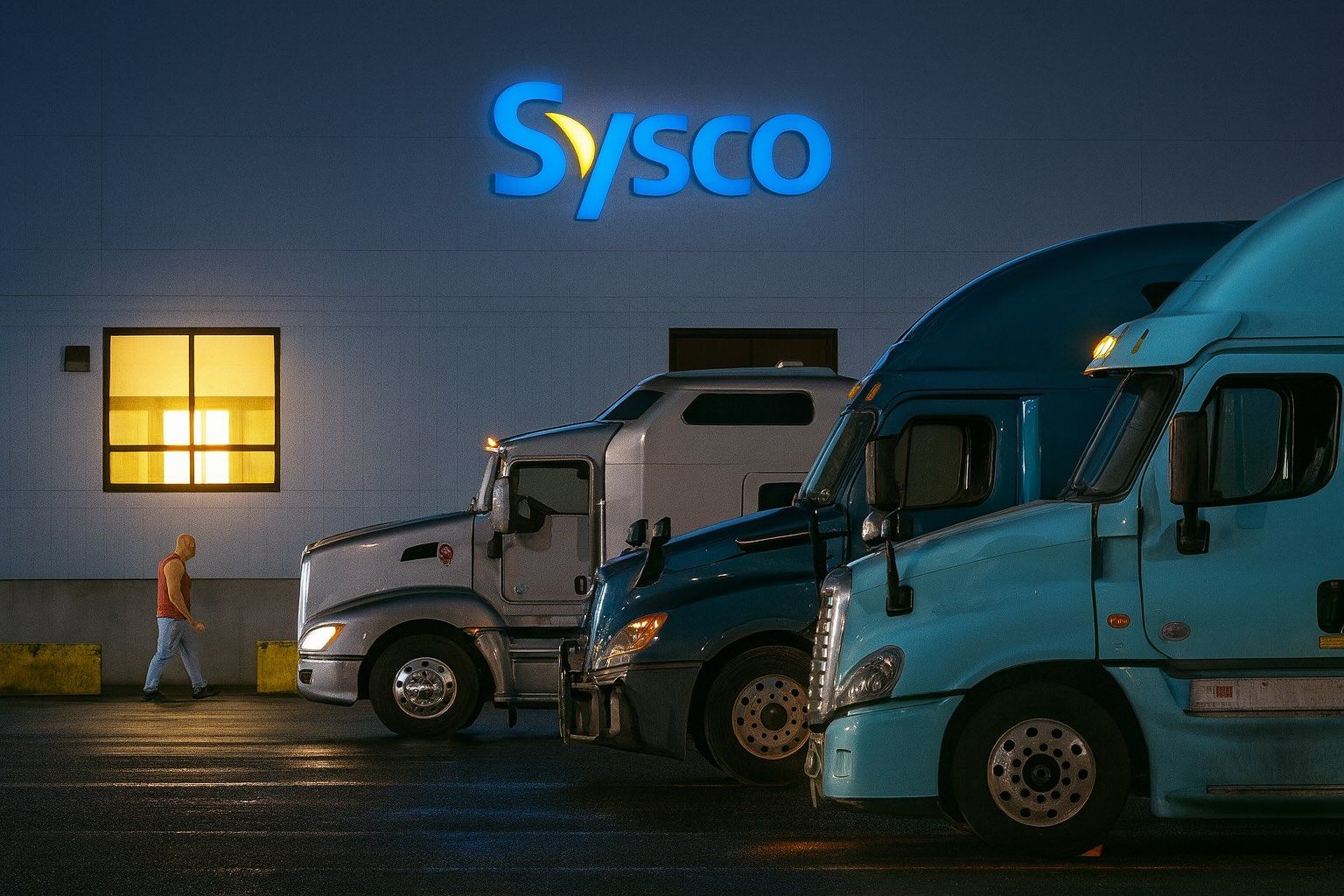- Earnings on Deck: Sysco Corporation will announce its first quarter fiscal 2026 financial results on October 28, 2025 and host a conference call at 10 a.m. EDT that day [1]. Investors are eager to see if the foodservice distributor can extend its growth momentum after beating expectations last quarter.
- Recent Results Beat: In the fourth quarter of FY2025 (Apr–Jun 2025), Sysco delivered an adjusted EPS of $1.48, topping analyst estimates of $1.39, on revenue of $21.14 billion (up 2.8% year-over-year) [2]. CEO Kevin Hourican noted the Q4 results “exceeded expectations” thanks to Sysco-specific initiatives and improved restaurant traffic [3]. Adjusted net earnings rose 3.3% despite slight volume declines, reflecting effective cost management amid ~3.5% product cost inflation [4].
- FY2026 Outlook: Sysco introduced guidance for fiscal 2026 calling for 3%–5% sales growth (to ~$84–85 billion revenue) and 1%–3% adjusted EPS growth (targeting ~$4.50–$4.60 EPS) [5]. Excluding a one-time compensation tailwind last year, underlying EPS is forecast to rise ~5%–7%, in line with long-term growth algorithms [6]. Management remains “cautiously optimistic,” focusing on execution amid macro uncertainties, according to CFO Kenny Cheung [7]. Cheung highlighted plans to reward shareholders with roughly $1 billion in dividends and $1 billion in share buybacks during FY2026 [8].
- Global Foodservice Leader: Sysco is the world’s largest food-away-from-home distributor, operating 337distribution facilities across 10 countries and serving about 730,000 customer locations [9]. The company generated $81 billion in sales in fiscal 2025 [10] – a scale that “dominates” the North American foodservice distribution sector alongside rival US Foods [11]. Sysco commands roughly a 17% share of the highly fragmented $370 billion U.S. foodservice market [12], distributing over 500,000 food and non-food products to restaurants, hospitals, schools, hotels and other venues.
- Stock Performance: SYY stock has been on a tear, recently touching a 52-week high around $83 per share [13]. The stock is up ~6.9% year-to-date, significantly outperforming the roughly 8.2% drop in the broader consumer staples/foodservice industry index [14]. Sysco shares trade at about 17.5× forward earnings, a premium to peers’ ~13.6× average, reflecting its market leadership [15]. Wall Street sentiment is broadly positive: at least 10 analysts rate SYY a “Buy” versus 4 “Hold,” with a consensus price target around $85–$86 (Moderate Buy rating overall) [16] [17].
- Dividends & Shareholder Returns: Sysco is a dividend stalwart – it declared a quarterly dividend of $0.54 per share (yield ~2.7%) payable on October 24, 2025 [18] [19]. Over the past year the company returned $2.3 billion to investors through $1.0B in dividends and $1.3B in share repurchases [20]. The planned $2 billion return in FY2026 underscores management’s confidence in cash flows [21]and commitment to shareholder value.
- Strategic Growth Initiatives: To fuel expansion, Sysco has pursued targeted acquisitions and innovations. It recently acquired Ready Chef (meal solutions) and Campbells Prime Meat (a specialty meat supplier in Scotland) to broaden its product portfolio [22]. The company is also piloting “Sysco To Go” retail concepts and leveraging its SYGMA network (quick-service restaurant distribution) to capture evolving food-away-from-home trends [23]. Internally, Sysco has driven operational efficiencies – cutting costs, streamlining processes, and expanding distribution capacity – to offset inflationary headwinds and softer restaurant demand [24] [25]. These efforts helped improve gross margins in Q4 and should support long-term growth despite near-term challenges.
- Challenges – Inflation and Costs: Like all food distributors, Sysco faces input cost inflation and margin pressure. In Q4 2025, product costs were up about 3.5% (notably in meat and dairy) [26], but Sysco managed to grow gross profit ~3.9% by effectively passing through costs and leveraging its scale. Higher operating expenses (including a one-time goodwill impairment) weighed on GAAP results [27], but adjusted operating income still rose modestly. With food commodity inflation now moderating, Sysco’s pricing power and procurement advantages could preserve profitability, though any resurgence of inflation or economic downturnposes a risk to volumes and margins. The company’s leverage is high (debt-to-equity around 6.7×) [28], so rising interest rates or credit tightening could constrain flexibility, though current financial health remains solid (Altman Z-score ~5.1 indicates low bankruptcy risk) [29].
- Labor Tensions: A brewing labor dispute adds to Sysco’s watchlist. Over 400 Teamsters-represented workers at Sysco’s San Francisco operation voted unanimously to authorize a strike if no new contract is reached by Oct. 31, 2025 [30] [31]. They seek higher wages and benefits to match deals at competitors, noting that “Sysco has absolutely no excuses” given its strong profits (Sysco earned $1.95 billion in net income in 2024, +10% YoY) [32]. Similar strike votes occurred in Portland (270 workers) and elsewhere, meaning nearly 800 West Coast employees could walk off the job in November if negotiations falter [33]. While Sysco has weathered labor actions before, extended disruptions in its supply chain or higher labor costs from new contracts could modestly impact near-term earnings. Management’s engagement with unions will be closely watched, as smooth operations are critical heading into the busy holiday season for foodservice.
Sysco Readies Q1 FY2026 Results Amid High Expectations
Sysco’s upcoming first quarter 2026 earnings release is highly anticipated on Wall Street. The company confirmed it will report Q1 results on October 28, 2025, followed by a conference call and webcast that morning for investors and analysts [34]. This quarterly update will cover the July–September 2025 period and set the tone for Sysco’s new fiscal year. Prior to the call, Sysco plans to publish its earnings press release and a slide deck on its investor relations site to provide detailed financial metrics and business trends [35].
Analysts are optimistic but also keenly watching for signs of continued momentum. Sysco ended fiscal 2025 on a strong note – as detailed below, its Q4 results beat expectations and management issued upbeat guidance for FY2026. Investors will look for evidence that restaurant and foodservice demand remains resilient into early FY2026, especially as inflation pressures evolve and consumers’ dining habits normalize post-pandemic. Any commentary on sales growth in different segments (local restaurants, institutional clients, international markets, etc.) or on how pricing and volumes are trending will be scrutinized. Sysco’s extensive global footprint (operations in 10 countries) means its results can also provide a window into the broader food-away-from-home industry health.
The earnings call on Oct. 28 will feature CEO Kevin Hourican and CFO Kenny Cheung discussing performance and taking questions. Given Sysco’s stature as an industry bellwether, analysts may inquire about topics like: the state of restaurant traffic, efforts to win market share from smaller distributors, integration progress of recent acquisitions, the impact of any commodity price swings, and how the company is managing expenses (labor, fuel, etc.) in the current environment. Sysco has also signaled it will use its Investor Relations website as the “primary channel” for key disclosures [36] – a reminder that investors should monitor the site for any material updates or presentations beyond the earnings release itself.
Strong Q4 2025 Performance Fuels Optimism
Sysco’s fourth quarter of fiscal 2025 (the 13 weeks ended June 28, 2025) gave investors plenty of reasons to be confident. The company surprised to the upside on both top and bottom lines. Revenue reached $21.1 billion, a +2.8% year-over-year increase [37], and adjusted earnings per share hit $1.48, up 6.5% from the prior year’s Q4 and about $0.09 above consensus estimates [38] [39]. This performance came despite slight declines in total case volume (−0.3%) and U.S. local case volume (−1.5%) due to soft industry traffic [40]. Sysco achieved higher sales and profit through a combination of strategic pricing, cost controls, and initiatives that drove efficiency.
Notably, gross profit rose 3.9% in Q4 to $4.0 billion [41], and gross margin ticked up by ~19 basis points [42], indicating Sysco was able to manage product cost inflation effectively. Food cost inflation ran about 3.5% in the quarter (especially in meat and dairy categories) [43], but Sysco’s scale and procurement strategies helped it pass on costs and even slightly expand margins. CEO Kevin Hourican credited “Sysco-specific initiatives and improved restaurant industry traffic” for the strong results [44]. In other words, Sysco’s internal efforts – such as targeted growth programs and operational improvements – coupled with a modest uptick in customer demand, led to better-than-expected financial outcomes. Hourican highlighted that U.S. Foodservice (USFS) local sales volume trends improved sequentially by 200 basis points through the quarter, with a “strong exit rate in June.” This momentum even continued into July, giving confidence as the new fiscal year began [45].
On a GAAP basis, some Q4 profitability metrics were down (e.g. reported EPS was $1.10, –10.6% YoY [46]) due to one-time items like a goodwill impairment in Sysco’s hospitality supply division [47]. However, excluding such charges, adjusted operating income actually grew ~1% and adjusted net income grew 3.3% [48] [49] – a solid achievement given the context. It’s clear that Sysco’s core business is on a stable growth trajectory, even in a mixed economic environment. The restaurant sector has faced some headwinds (for example, industry-wide foot traffic dipped ~1% in mid-2025 [50]), but restaurants and foodservice providers are still seeing consistent demand as consumers continue dining out. Sysco’s broad customer base (from independent eateries to chain restaurants and institutional cafeterias) provides some insulation – weakness in one area can be offset by strength in another. For instance, Sysco’s international segment delivered “double-digit profit growth” in Q4 [51], helping to balance softer U.S. trends.
Importantly for investors, Sysco’s strong finish to FY2025 sets a baseline that the company aims to build upon. The company’s ability to outperform expectations in Q4 – and management’s commentary about ongoing momentum – have raised expectations that Sysco will show year-over-year growth in Q1 FY2026. The first quarter is seasonally important, as it covers the summer period when restaurants are typically busy. Moreover, any early FY2026 gains could validate Sysco’s strategic moves (like acquisitions and new services) as drivers of incremental growth.
FY2026 Guidance Signals Steady Growth Ahead
Alongside its year-end results, Sysco issued guidance for fiscal year 2026 that points to modest, steady growth and continued shareholder returns. The company expects full-year 2026 sales of approximately $84–85 billion, which would mark about a 3%–5% increase over FY2025 [52]. This implies Sysco sees underlying demand remaining solid, with perhaps slight volume upticks and some pricing lift. For earnings, Sysco forecast adjusted EPS in the range of $4.50 to $4.60, roughly 1%–3% growth from the FY2025 adjusted EPS of $4.46 [53] [54]. On the surface, mid-single-digit revenue growth but low-single-digit profit growth suggests margin pressures; however, management explained that a unique factor is at play.
CFO Kenny Cheung noted that Sysco will lap an unusually low incentive compensation expense in FY2025 (it had cut bonus payouts), which creates a $100 million headwind in FY2026 earnings comparisons (equating to ~$0.16 per share) [55]. Excluding that accounting headwind, “our outlook reflects EPS growth of ~5% to 7%, with the midpoint in line with our long-term algorithm,” Cheung said [56]. In other words, Sysco’s core earnings power is expected to advance at a mid-single-digit rate, consistent with its strategic plan, once that one-off item is normalized. This nuance gave analysts comfort that Sysco is not fundamentally losing momentum – the lower headline EPS growth is more of a timing/accounting issue, not a deterioration in business fundamentals.
Cheung’s commentary struck an optimistic yet prudent tone. He emphasized that Sysco’s teams are “focusing on operational execution in the backdrop of continued macro uncertainties” [57]. Management is well aware that factors like interest rates, food inflation, and consumer spending could fluctuate in the coming year, so they are controlling what they can – costs, service levels, and strategic initiatives. Sysco’s track record through the pandemic and recovery has shown it can adapt (for instance, pivoting to supply grocery channels in 2020 when restaurants were shut, then refocusing on hospitality as it rebounded). Heading into 2026, the company appears to be balancing growth investments with caution about the economy.
Notably, Sysco’s guidance also came with a strong commitment to return cash to shareholders. The company expects to distribute about $1 billion in dividends and $1 billion in share repurchases in FY2026 [58]. This mirrors the roughly $2.3 billion returned in FY2025 [59] and sends a clear signal: Sysco is generating robust cash flows and is confident enough in its outlook to keep rewarding investors. The dividend was recently increased to $0.54 per quarter (annualized $2.16), and buybacks will continue to reduce share count over time. For a mature company, these shareholder returns are a key part of total investment return. Analysts often highlight Sysco’s reliable dividend (it has decades of uninterrupted payouts) and find comfort in management’s willingness to deploy excess cash to buy back stock, which can bolster EPS growth.
To the extent Sysco’s Q1 results on Oct. 28 align with or exceed the trajectory implied by this guidance, it will reinforce the message that the company is on track. Conversely, any hiccup or cautious revision would be notable since the bar has been set. At present, however, analysts generally view Sysco’s FY2026 targets as achievable and slightly conservative, given the company’s scale advantages and initiatives in place [60] [61]. In fact, the consensus earnings estimate for FY2026 is about $4.58 (roughly 2% growth) [62] [63], squarely within Sysco’s range. This suggests the market has largely accepted the company’s guidance at face value. The upcoming quarters will reveal if there is upside to those numbers if execution is strong or if any external factors cause deviation.
Market Leadership and Competitive Landscape
Sysco’s dominant market position underpins much of its investment appeal. The company is often described as the 800-pound gorilla of foodservice distribution – and with good reason. In the U.S. foodservice distribution market (worth ~$370 billion), Sysco is the largest player with approximately a 17% share [64]. For context, the industry is fragmented among many regional and specialized distributors. Sysco’s nearest competitor, US Foods, is roughly half its size. Industry analysts note that in North American foodservice, “giants like Sysco and US Foods dominate” [65]while numerous smaller firms compete in niches. Sysco leverages unparalleled scale: it operates hundreds of distribution centers and a massive fleet of trucks to reach customers everywhere. This scale yields purchasing power with suppliers (lowering cost of goods) and the ability to offer a broader product catalog and reliable delivery to clients big and small.
Who are Sysco’s customers? Essentially any organization that serves meals outside the home – from independent restaurants and chain eateries, to hotels and resorts, hospitals, schools, universities, nursing homes, sports arenas, and more [66]. If you dine at a restaurant or catered event, there’s a good chance some ingredients came off a Sysco truck. In fiscal 2025, about 70% of Sysco’s revenue came from U.S. foodservice operations, ~18% from international units (Canada, UK, France, etc.), and ~10% from its SYGMA quick-service segment that supplies fast-food restaurants [67]. This mix illustrates Sysco’s diversification: it isn’t reliant on any one region or customer type. The international division has been growing as Sysco expands abroad; for instance, Sysco acquired the UK’s Brakes Group in 2016 and more recently Campbells Prime Meat in Scotland in early 2025 [68]. Those moves extend Sysco’s footprint and product offerings (e.g. specialty meats in the UK market).
Sysco also differentiates itself by offering value-added services. Beyond delivering boxes of food, Sysco helps restaurants with menu planning, kitchen equipment, and even technology solutions. The company notes it provides “customized supply chain solutions, bespoke specialty products, and culinary support” to help customers optimize operations [69]. This one-stop-shop approach makes Sysco a critical partner to many small restaurants that lack large procurement teams. It also creates stickier relationships – switching away from Sysco isn’t just finding a new vendor, it could mean losing advisory support or consistent quality supply.
That said, competition remains intense. Food distribution is a low-margin, volume-driven business, and regional players or specialist distributors (for organic foods, produce, seafood, etc.) constantly vie for business. Major national clients (like restaurant chains or hotel groups) often bid out contracts to keep Sysco’s pricing keen. Sysco’s scale can be a double-edged sword: while it can outcompete on breadth and efficiency, some customers may prefer smaller local suppliers for personalized service or niche products. Additionally, broadline distributors (like Sysco) face some channel blurring – e.g., big retail grocers like Walmart and Kroger have their own supply chains and are even selling to small restaurants in some cases [70]. However, Sysco’s management remains confident that its combination of extensive distribution infrastructure, product variety (500,000+ SKUs), and value-added services is tough to match at the national/global scale [71].
Sysco’s recent strategic moves underscore its intent to stay number one. One pillar has been acquisitions: for example, the purchase of Ready Chef (a prepared meals and meal kit company) broadens Sysco’s offerings for foodservice operators looking for partially prepped ingredients [72]. The acquisition of Campbells Prime Meat gave Sysco a stronger position in high-end protein supply in the UK [73]. Sysco also earlier acquired Paris-based DAC in 2023 to bolster European presence. By folding such companies into its network, Sysco can cross-sell more products to existing customers and enter new verticals.
Another pillar is innovation and new channels. Sysco is exploring direct-to-consumer or retail adjacencies through pilots like “Sysco To Go” convenience stores [74], which could drive demand for its products in new ways. It is also investing in digital ordering platforms and data analytics for customers, keeping it ahead of tech-savvy upstarts.
Lastly, Sysco is focused on operational excellence – a must in a business with slim margins (~3-4% net margin [75]). The company has implemented cost-saving programs, route optimizations, and even electric trucks in some fleets to reduce fuel costs. These efficiency moves helped Sysco keep its adjusted operating expenses in check (+4.9% in Q4, slightly below gross profit growth) [76]. Sysco’s ability to execute on cost controls was evident when it maintained an adjusted EBITDA margin around 5.1% [77] even as some costs rose. Management has indicated that continuous improvement in productivity is part of Sysco’s culture now, which should help protect profitability if economic conditions tighten.
In summary, Sysco enters FY2026 in a position of strength within its industry. It holds the leading market share, has global reach, and is actively adapting through acquisitions and new services. These advantages form a moat against competition, though Sysco must remain vigilant to retain key customers and to respond to any innovative disruptors. For investors, Sysco’s market leadership suggests it can capture a good portion of any growth in the foodservice sector – and industry projections generally call for gradual expansion as consumers maintain their dining-out habits. Even as grocery stores try to lure customers back to eating at home, the convenience and experience of restaurants keep the food-away-from-home segment growing, which bodes well for Sysco.
Investor Sentiment: Stock Near Highs and Analysts Upbeat
Sysco’s solid fundamentals and consistent execution have been rewarded in the stock market. SYY shares have climbed roughly 7% in 2025 (year-to-date), recently hitting 52-week highs in the $83 range [78] [79]. By early October 2025, the stock was trading near its highest level in over a year, reflecting investor confidence ahead of the Q1 earnings release. This outperformance is especially notable given that many consumer staples and food industry stocks have lagged – Sysco’s industry peers (food distribution and consumer staples sector) have seen an average 8% drop year-to-date [80]. Sysco bucking that trend signals that the market views it as a resilient, best-in-class operator in a defensive industry. In times of economic uncertainty, investors often gravitate to companies like Sysco which sell essential goods (food) and have stable cash flows.
Analyst coverage on Sysco is generally positive. According to MarketBeat data, 11 out of 15 analysts rate Sysco a “Buy”, with the rest mostly Holds and no Sells [81] [82]. The average 12-month price target is about $85–$86 per share [83] [84], roughly 6-8% above the current price – suggesting moderate upside. Several Wall Street firms raised their targets after Sysco’s Q4 beat and FY2026 guidance: for example, Bank of America hiked its target from $81 to $93 and reiterated a Buy rating back in July [85]. Other firms like Wells Fargo and Truist also issued Buy ratings with targets in the high-$80s [86]. The bullish thesis typically cites Sysco’s market dominance, improvements in profitability, and shareholder-friendly capital returns. Even those with Hold ratings often acknowledge the company’s strengths but feel the stock’s valuation already reflects them.
On that point, Sysco’s valuation is somewhat elevated relative to its history and peers. The stock trades around 21–22 times trailing earnings, or about 17.5× forward earnings based on FY2026 estimates [87]. This P/E ratio is higher than the industry’s ~13.5× [88] and above Sysco’s smaller competitors. Investors appear willing to pay a premium for Sysco’s scale, reliability, and dividend. As a steady earnings grower with a defensive business, Sysco is viewed as a quasi-“safe haven” stock that can still deliver growth. Its PEG ratio (~2.5) indicates the valuation isn’t a screaming bargain, but neither is it in bubble territory for a stable blue-chip. For context, during the pandemic crash in 2020, Sysco’s stock (and earnings) were hit hard as restaurants closed, but since then, it has steadily recovered and the business is now larger than pre-pandemic. That recovery and continued growth narrative supports the current valuation.
The institutional investor community has a strong presence in Sysco. Roughly 83%–89% of Sysco’s shares are held by institutional investors (mutual funds, pension funds, etc.), demonstrating high confidence from professional money managers [89] [90]. Lately, even as the stock climbed, institutions have been net buyers. For example, Merit Financial Group LLC disclosed increasing its stake in SYY by 29% in Q2 2025, now holding about 51,200 shares (worth $3.88 million) [91]. Dozens of other funds made small adds to their positions as well [92] [93]. The broad ownership base and continued accumulation suggest Sysco is a core long-term holding for many, prized for its consistent returns. Insider ownership, by contrast, is low (under 1% of shares) [94], and while there have been some insider stock sales by executives (profit-taking after share price gains) [95] [96], these have not raised red flags about insider confidence in the company’s prospects.
For dividend-focused investors, Sysco’s dividend track record is a selling point. The current yield is about 2.6%–2.7% [97], and the dividend has been steadily growing over time (Sysco typically raises it annually; in fact, the $0.54 quarterly rate is up from $0.50 last year). The payout ratio stands at ~58% of earnings [98] [99], a manageable level that allows room for growth while retaining earnings for reinvestment. Sysco’s plan to repurchase ~$1 billion in stock this year (over 3% of its market cap) effectively returns even more capital to shareholders and boosts metrics like EPS by shrinking the share count. These factors make SYY attractive to both growth and income investors, a rare combination.
Going into the Q1 results, the stock’s recent strength indicates that investor expectations are high. Any significant beat or raise in outlook could push shares into new high territory, whereas a miss or cautious commentary might spur a pullback from the highs. The broader market conditions (interest rates, consumer sentiment) will also play a role. But given Sysco’s consistent performance, many analysts see dips in the stock as buying opportunities. Zacks Investment Research currently assigns Sysco a Rank #3 (Hold), reflecting a neutral short-term view, but also notes the company’s long-term growth initiatives and market leadership as positives [100] [101]. In summary, sentiment around Sysco remains more positive than not, anchored by its blue-chip status in a defensive industry and its proven ability to deliver shareholder value.
Risks and Challenges: Costs, Labor, and Economic Uncertainty
While Sysco’s outlook is largely favorable, the company does face a set of challenges and risk factors that investors are monitoring:
1. Cost Pressures & Inflation: Food price inflation has been a double-edged sword for Sysco. On one hand, inflation (e.g. 3.5% in Q4 [102]) boosts sales dollars since Sysco passes through higher costs. On the other hand, if costs rise too quickly or unpredictably, it can squeeze margins or dent demand (restaurants may suffer if food costs surge, potentially reducing orders). Thus far, Sysco has handled inflation adeptly – leveraging its size to negotiate prices and implementing fuel surcharges or price increases as needed. However, volatile commodity prices (produce impacted by weather, meat by disease outbreaks, etc.) remain an ever-present risk. A return of high inflation could force tough conversations with customers over pricing. Conversely, an outright deflation in food prices, while less likely, could also cut into sales growth. Sysco’s strategy is to use its vast product mix to mitigate specific category spikes and to continue driving internal efficiency to protect margins. Still, inflation and supply chain costs (fuel, trucking, packaging) will be important swing factors for earnings in coming quarters.
2. Labor and Workforce Issues: Sysco’s size means it employs tens of thousands of workers – 75,000 associates globally [103], including warehouse staff and truck drivers who are often unionized. Labor relations are heating up: as noted, Teamsters unions on the U.S. West Coast have authorized strikes involving up to ~800 employees if contract negotiations stall [104]. The San Francisco Teamsters (Local 853) vote in October 2025 was unanimous to strike after Oct. 31 if needed [105] [106]. They argue that in a high-cost region, Sysco’s wage offer must “keep up with inflation” and match what Teamsters have won at competitors [107]. Indeed, a nearby US Foods facility recently unionized and secured a strong contract, raising the bar [108]. For Sysco, a strike could temporarily disrupt service to customers in that region. The company would likely reroute supplies from other centers or use non-union staff, but there’s risk of customer impact and extra cost. Moreover, if Sysco concedes higher pay and benefits, that could raise its cost structure. The outcome in California could influence labor situations in other markets as well. Beyond these union issues, driver shortages and rising wage rates in logistics generally pose a challenge industry-wide. Sysco has increased pay in many areas to attract talent (especially CDL drivers), and while it can often pass some of this cost to customers, a tight labor market can pressure margins.
3. High Leverage and Interest Rates: Sysco carries a sizable debt load, the legacy of years of acquisitions and share buybacks. Its debt-to-equity ratio is around 6.7–7.9 (depending on accounting of leases) [109] [110], which is high for a distribution company. In absolute terms, Sysco has over $10 billion in debt. While the company has no trouble servicing this debt (interest coverage is ample, and it retains investment-grade credit ratings), the era of rising interest rates means new debt or refinanced debt will come at a higher cost. Sysco will have to allocate part of its cash flow to interest payments rather than business investment or shareholder returns, which could modestly hamper financial flexibility. So far, Sysco’s earnings growth and cash generation have outpaced interest expense growth, and its Altman Z-score of ~5.1 indicates very low risk of financial distress [111]. Nonetheless, deleveraging could become a priority if economic conditions worsen. Management might slow the pace of buybacks, for example, to ensure debt metrics remain solid. Investors generally aren’t alarmed by Sysco’s leverage (common in the industry), but it is a factor to watch if credit markets tighten.
4. Economic Cyclicality: Although food is a defensive category, Sysco is not completely immune to the broader economy. In a recession or consumer spending downturn, restaurant patronage typically declines as people cut discretionary outings. During COVID-19, Sysco’s sales plunged when restaurants were forced shut – a dramatic example of how sales are tied to the operating status of its customers. In a less extreme scenario, a mild recession could still see lower foot traffic at restaurants, fewer catered corporate events, and tighter budgets at institutional clients, all of which would crimp Sysco’s volume. Management has cited “continued macro uncertainties” [112] as a reason to focus on execution and not over-extend guidance. Should economic signals deteriorate (e.g. rising unemployment, lower consumer confidence), Sysco’s growth might slow. However, the company can lean on its diverse customer base – for instance, if fine dining falters, perhaps budget-friendly quick-service restaurants (supplied by Sysco’s SYGMA segment) see less impact, balancing the scales. Geographic diversity also helps: if the U.S. market softens, Sysco’s international operations (18% of revenue) could offset if they are in a different phase of the cycle.
5. Competition and Customer Loss: Another risk is competitive pressure causing customer losses or margin concessions. While Sysco is the giant, customers do have choices. If a rival offers a lower price or specialized service, Sysco could lose accounts. The company’s recent note that some independent grocers are insourcing distribution or that big chains are self-distributing [113] highlights that not all growth is guaranteed. There’s also the risk of technological disruption – for example, ecommerce entrants trying to connect food suppliers directly with restaurants (bypassing traditional distributors) via online marketplaces. So far, none have seriously dented Sysco’s business model, but it’s an area to monitor. Sysco’s answer has been to emphasize its full-suite value (including advice, reliability, and one-stop convenience) which pure marketplaces might lack. Additionally, Sysco’s massive network yields economies of scale that newcomers would struggle to replicate. Nonetheless, maintaining top-tier customer service is crucial for Sysco to keep its clientele in the face of competition.
In weighing these risks, many analysts conclude that Sysco’s strengths outweigh the challenges. The company has navigated inflation, labor issues, and economic cycles for decades. For instance, Sysco is proactively addressing labor concerns by negotiating (rather than fighting) – in prior disputes, it often reached settlements that balanced worker needs and company capabilities. Also, the fact that Sysco remained profitable and cash-flow positive even during the 2020 pandemic shock gives confidence in its resilience. The current labor disputes, if resolved with reasonable wage increases, might slightly raise costs but could also improve employee retention and productivity, which is a long-term benefit. As for inflation and economy-wide issues, Sysco’s scale and diversification act as buffers.
Outlook: Cautious Optimism as Results Approach
As Sysco prepares to report its first quarter of FY2026, the stage is set for a closely watched announcement. All signs point to a company that is executing well and capitalizing on its market leadership, even as it faces the same headwinds affecting the broader industry. The upcoming results will show whether Sysco is starting the new fiscal year on a strong footing: investors will be looking for at least low-to-mid single digit growth in sales and earnings consistent with the full-year guidance. Any commentary about trends in July–September (for example, improving restaurant traffic, easing inflation, or progress on strategic initiatives) will be parsed for hints about the rest of FY2026.
The bigger picture for Sysco is that it operates in a fundamentally stable business – people will continue to dine out and institutions will continue to need foodservice – but it must continuously adapt and execute to maintain its edge. Fortunately, the company’s recent track record (beat-and-raise quarters, focused strategy, shareholder returns) suggests it is doing just that.
Analysts and experts largely remain bullish on Sysco’s prospects. As one industry report put it, Sysco’s “strong financial metrics with consistent revenue growth and profitability” underscore its ability to thrive despite operational challenges [114] [115]. The coming earnings call will be an opportunity for Sysco to validate that confidence. If the company can show that its growth initiatives (like new acquisitions and cost efficiencies) are contributing and that demand remains healthy, it could further justify the stock’s strong performance. Conversely, management will need to address concerns such as the Teamsters labor situation – investors will want assurance that any disruptions will be minimal and that Sysco is working toward fair agreements.
In sum, Sysco enters the Q1 report with momentum on its side: sales are rising, profits are growing (albeit at a moderate pace), and the stock is near highs. The balance of commentary from management – acknowledging challenges while demonstrating plans to overcome them – will be crucial. With a solid dividend, ongoing buybacks, and a dominant competitive position, Sysco offers a mix of offense and defense that has broad appeal in the current market. The first quarter results and outlook update on October 28 will help confirm whether the company’s fiscal 2026 is on track to deliver the “profitable growth” that CEO Kevin Hourican has promised [116]. Investors, for now, have good reason to watch closely, as Sysco’s performance often mirrors the health of the dining economy itself – and by extension, provides insights into consumer trends in food consumption globally.
Sources:
- GlobeNewswire Press Release – “Sysco to Announce First Quarter Fiscal Year 2026 Financial Results On October 28”, Oct. 7, 2025 [117] [118].
- QuiverQuant News – “Sysco Corporation to Host Conference Call for Q1 FY2026 Results on Oct 28, 2025”, Oct. 7, 2025 [119] [120].
- MarketBeat – “Merit Financial Group LLC Has $3.88 Million Position in Sysco (SYY)”, Oct. 7, 2025 [121] [122].
- MarketBeat – “Sysco (NYSE:SYY) Reaches New 52-Week High – Here’s Why”, Oct. 1, 2025 [123] [124].
- TS2.tech (Tech Times) – “UNFI Stock Rockets… Organic Growth Tailwinds” (Sysco context) [125].
- Sysco FY2025 Earnings Release – “Sysco Reports Fourth Quarter and Full Year 2025 Results; Introduces FY26 Guidance”, Jul. 29, 2025 [126] [127].
- AndNowUKnow – “Sysco Q4 2025 Results… Kevin Hourican and Kenny Cheung Comment”, Jul. 30, 2025 [128] [129].
- GuruFocus – “Sysco (SYY) Faces Potential Strike Amid Labor Disputes”, Oct. 6, 2025 [130] [131].
- Teamsters Press Release – “Sysco Teamsters in California Authorize Strike”, Oct. 6, 2025 [132] [133].
- Nasdaq/Zacks – “Will Sysco’s Expansion Efforts and Market Leadership Fuel Growth?”, Sep. 23, 2025 [134] [135].
References
1. www.globenewswire.com, 2. www.marketbeat.com, 3. www.andnowuknow.com, 4. investors.sysco.com, 5. www.andnowuknow.com, 6. www.andnowuknow.com, 7. investors.sysco.com, 8. www.andnowuknow.com, 9. www.globenewswire.com, 10. www.globenewswire.com, 11. ts2.tech, 12. www.gurufocus.com, 13. www.marketbeat.com, 14. www.nasdaq.com, 15. www.nasdaq.com, 16. www.marketbeat.com, 17. www.marketbeat.com, 18. www.marketbeat.com, 19. www.marketbeat.com, 20. investors.sysco.com, 21. www.andnowuknow.com, 22. www.nasdaq.com, 23. www.nasdaq.com, 24. www.nasdaq.com, 25. www.nasdaq.com, 26. investors.sysco.com, 27. investors.sysco.com, 28. www.marketbeat.com, 29. www.gurufocus.com, 30. teamster.org, 31. teamster.org, 32. teamster.org, 33. teamster.org, 34. www.globenewswire.com, 35. www.globenewswire.com, 36. www.globenewswire.com, 37. www.andnowuknow.com, 38. www.andnowuknow.com, 39. www.marketbeat.com, 40. www.nasdaq.com, 41. www.andnowuknow.com, 42. investors.sysco.com, 43. investors.sysco.com, 44. www.andnowuknow.com, 45. www.andnowuknow.com, 46. www.andnowuknow.com, 47. investors.sysco.com, 48. www.andnowuknow.com, 49. www.andnowuknow.com, 50. www.nasdaq.com, 51. investors.sysco.com, 52. www.andnowuknow.com, 53. www.andnowuknow.com, 54. investors.sysco.com, 55. www.andnowuknow.com, 56. www.andnowuknow.com, 57. www.andnowuknow.com, 58. www.andnowuknow.com, 59. investors.sysco.com, 60. www.andnowuknow.com, 61. www.nasdaq.com, 62. www.marketbeat.com, 63. www.marketbeat.com, 64. www.gurufocus.com, 65. ts2.tech, 66. www.globenewswire.com, 67. www.gurufocus.com, 68. www.nasdaq.com, 69. www.globenewswire.com, 70. ts2.tech, 71. www.gurufocus.com, 72. www.nasdaq.com, 73. www.nasdaq.com, 74. www.nasdaq.com, 75. www.gurufocus.com, 76. investors.sysco.com, 77. www.gurufocus.com, 78. www.marketbeat.com, 79. www.nasdaq.com, 80. www.nasdaq.com, 81. www.marketbeat.com, 82. www.marketbeat.com, 83. www.marketbeat.com, 84. www.marketbeat.com, 85. www.marketbeat.com, 86. www.marketbeat.com, 87. www.nasdaq.com, 88. www.nasdaq.com, 89. www.marketbeat.com, 90. www.gurufocus.com, 91. www.marketbeat.com, 92. www.marketbeat.com, 93. www.marketbeat.com, 94. www.marketbeat.com, 95. www.marketbeat.com, 96. www.marketbeat.com, 97. www.marketbeat.com, 98. www.marketbeat.com, 99. www.marketbeat.com, 100. www.nasdaq.com, 101. www.nasdaq.com, 102. investors.sysco.com, 103. www.globenewswire.com, 104. teamster.org, 105. teamster.org, 106. teamster.org, 107. teamster.org, 108. teamster.org, 109. www.marketbeat.com, 110. www.gurufocus.com, 111. www.gurufocus.com, 112. investors.sysco.com, 113. ts2.tech, 114. www.gurufocus.com, 115. www.gurufocus.com, 116. www.andnowuknow.com, 117. www.globenewswire.com, 118. www.globenewswire.com, 119. www.quiverquant.com, 120. www.quiverquant.com, 121. www.marketbeat.com, 122. www.marketbeat.com, 123. www.marketbeat.com, 124. www.marketbeat.com, 125. ts2.tech, 126. www.andnowuknow.com, 127. www.andnowuknow.com, 128. www.andnowuknow.com, 129. www.andnowuknow.com, 130. www.gurufocus.com, 131. www.gurufocus.com, 132. teamster.org, 133. teamster.org, 134. www.nasdaq.com, 135. www.nasdaq.com








